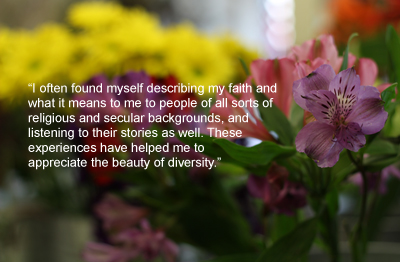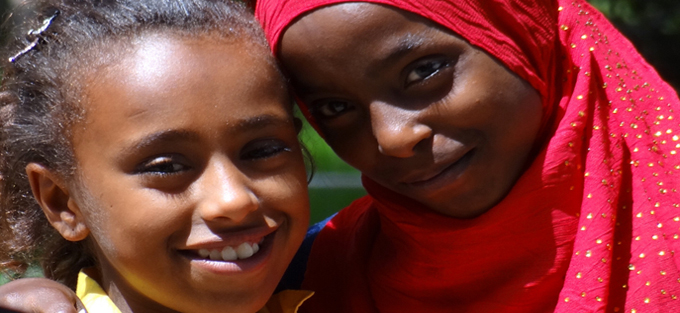by Samantha Nichols
In the parable we call “The Good Samaritan,” Jesus reminds us that our neighbors are not only those with whom we agree or those we like. In his time and place, Jews and Samaritans bore a great deal of animosity toward one another, and yet, it is a Samaritan who exemplifies what it means to be a good neighbor in Jesus’ story.
“Just then a lawyer stood up to test Jesus. ‘Teacher,’ he said, ‘what must I do to inherit eternal life?’ He said to him, ‘What is written in the law? What do you read there?’ He answered, ‘You shall love the Lord your God with all your heart, and with all your soul, and with all your strength, and with all your mind; and your neighbor as yourself.’ And he said to him, ‘You have given the right answer; do this, and you will live.’ But wanting to justify himself, he asked Jesus, ‘And who is my neighbor?’ Jesus replied, ‘A man was going down from Jerusalem to Jericho, and fell into the hands of robbers, who stripped him, beat him, and went away, leaving him half dead. Now by chance a priest was going down that road; and when he saw him, he passed by on the other side. So likewise a Levite, when he came to the place and saw him, passed by on the other side. But a Samaritan while traveling came near him; and when he saw him, he was moved with pity. He went to him and bandaged his wounds, having poured oil and wine on them. Then he put him on his own animal, brought him to an inn, and took care of him. The next day he took out two denarii, gave them to the innkeeper, and said, ‘Take care of him; and when I come back, I will repay you whatever more you spend.’ Which of these three, do you think, was a neighbor to the man who fell into the hands of the robbers?” He said, ‘The one who showed him mercy.’ Jesus said to him, ‘Go and do likewise.’” (Luke 10:25-37)
In the Bible, we are commanded to love God and our neighbors as ourselves. The parable of the Good Samaritan speaks to the beauty of interfaith dialogue.
When I was in college, I heard this story again from a Muslim. Eboo Patel, founder of the Interfaith Youth Core, deepened my appreciation for the story and expanded its meaning for me.
A couple years later in seminary, I took a class called “Christians and Muslims.” The course offered a historical overview of relations between the two religious groups, highlighting moments of both cooperation and conflict.
For hundreds of years, Christians and Muslims have been neighbors. But here in the United States, our Muslim neighbors are often looked at with suspicion or even hate (as reported in the 2014 Pew survey and the 2014 FBI report.)
The question then is who will we be in the story of the Good Samaritan? Are we the robbers, jeopardizing the safety and well-being of our neighbors? Or are we the priest or Levite, walking right by these injustices without reaching out a hand to help?
Perhaps we can be the Good Samaritan, the one who shows mercy. Building upon that, we can be interfaith leaders who show not only mercy, but a friendly interest in learning more about all our neighbors and serving and organizing our communities to include those whose beliefs are different from our own.
What a Jewish Rabbi taught me about being Lutheran
After starting my undergraduate degree in world religion, I began to ponder theological questions about the Christian story that had long troubled me. I considered converting to Judaism and even sat down to talk with a rabbi.
The rabbi asked me what attracted me to Judaism. I named my theological concerns and then explained that I was impressed with the justice work of the Reform Jewish tradition. The rabbi paused before saying, “Well, you know, a lot of the work we do in the community we do in partnership with the church, the Lutheran church in particular.”
I remembered the hope inherent to the story of Christ’s resurrection, a hope I did not wish to leave behind. What followed that conversation were many opportunities to further explore my Lutheran identity.
It was a Muslim person who helped me to rediscover the parable of the Good Samaritan and a Jewish person who helped me reexamine the faith of my childhood when I wanted to leave it behind. I am deeply grateful to both.
 At Interfaith Leadership Institutes, I often found myself describing my faith and what it means to me to people of all sorts of religious and secular backgrounds, and listening to their stories as well. These experiences have helped me to appreciate the beauty of diversity. So much of what I understand about myself and so much of my call to ordained ministry in the ELCA stem from my experiences with interfaith dialogue.
At Interfaith Leadership Institutes, I often found myself describing my faith and what it means to me to people of all sorts of religious and secular backgrounds, and listening to their stories as well. These experiences have helped me to appreciate the beauty of diversity. So much of what I understand about myself and so much of my call to ordained ministry in the ELCA stem from my experiences with interfaith dialogue.
We are surrounded by neighbors. Some of our neighbors are sitting next to us in the pews on Sunday. Others are praying at different times, in different places, in different languages. Others are not praying at all, perhaps subscribing to a secular worldview instead. All these people are our neighbors. With all these people we have exciting differences and meaningful shared values. We are called to love our neighbors as ourselves, to show mercy and to serve our communities. The good Samaritan reached out to someone who was different and offered compassion. As Jesus said, “Go and do likewise.”
Discussion questions:
1. Who are your neighbors? What other religious and secular groups exist within your communities?
2. What encounters have you had with people from different religious and secular backgrounds?
3. How can we mobilize congregations to engage in interfaith dialogue?
Closing prayer:
God of compassion, in this time of religious tension, guide us to be like the Good Samaritan. We thank you for creating this world of diversity. Help us to reach out to those with whom we differ theologically. Inspire us to have conversations and build communities with our many beautiful and diverse neighbors. Amen.
Samantha Nichols is her first year of seminary at the Lutheran School of Theology at Chicago. She is seeking a Master of Divinity with hopes of becoming a pastor for the ELCA. A graduate of Missouri State University, Samantha majored in Religious Studies and minored in Ozarks Studies. She received the Mike Hammer Interfaith Leadership Award from Interfaith Youth Core in 2015.
Photo by Adam Jones. Used with permission.

